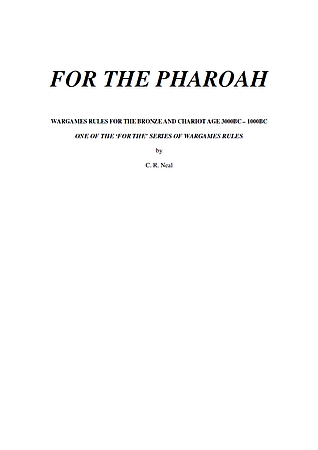
For the Pharoah
I originally wrote these rules for myself, because I was not happy with any of the commercially available sets. They either allowed players omnipresence on the table or restricted them with complex action points mechanisms, some to the degree of imitating chess or ludo. I felt that something between these two extremes was required. They are evolutionary rather than revolutionary although some aspects of them are innovative.
These rules evolved from an original Napoleonic set. At first, they were expanded separately into the eighteenth and mid nineteenth centuries. When efforts were made to incorporate none European armies into the rules I realised that I had the essence of a set that could span all the periods from ancient to colonial.
What developed was a core system with common rules for command; morale movement; shooting and melee. Rules for specific periods are added as and when necessary without altering this core system. Such an approach simplifies understanding throughout the series.
The aim is most emphatically not to allow un-historical battles such as ancient Egyptians fighting Boers, or any other stupid combination, but to use the same basic mechanisms when using these two armies.
– For the Pharoah introduction
- Designer
- C.R. Neal
- Year Published
- 2004
- Status
- In Print
- Contents
- Available online (57-page PDF)
- Scale
- Figure Size
- These rules are primarily written for the 15mm scale. This is still probably the most popular size and is the median between the 5mm and 25mm scales. Other sizes can be used, (see the section near the end on alterative scales).
- Ground Scale
- The ground scale used is one table millimetre is equal to one metre. This is a simple and easy comprehensible ratio. The metric system is so well known that I do not foresee any complication in rejecting imperial measurements. All distances in these rules will be quoted in centimetres.
- Figure Ratio
- The figure ratio is 50:1, one figure represents fifty men, with or without mounts, and the ratio for models is 2:1. This ratio does not require too many troops for a large army, hence keeping the cost down, whilst at the same time units look like units, and the table does not look like an abstract chessboard.
- Time Scale
- The time scale has deliberately not been defined but movement rates are based on the distances that the various troops would cover in about one minute.
– For the Pharoah page 5-6
- Basing
I am not a stickler for base sizes. The only thing that is important is that four close order must have the same frontage as three medium order or two open order figures or a single chariot model. Base depth is of less importance.
– For the Pharoah page 5
Back to RULES DIRECTORY
Areas of InterestAncients
Featured Hobby News Article
Featured Link
Top-Rated Ruleset
Featured Showcase Article
Featured Profile Article The Editor tries out this first-year gaming convention in the San Francisco Bay Area (California).
Featured Book Review
|
Wargames Rules for the Bronze and Chariot Age 3000BC-1000BC
|



